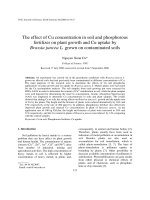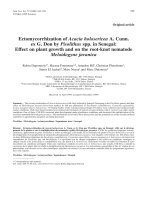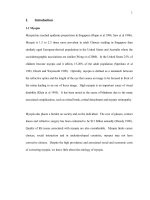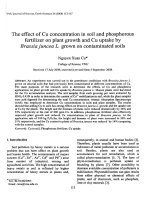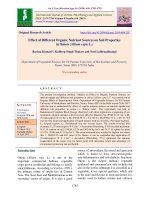Effect of seed priming on plant growth and bulb yield in onion (Allium cepa L.)
Bạn đang xem bản rút gọn của tài liệu. Xem và tải ngay bản đầy đủ của tài liệu tại đây (227.59 KB, 8 trang )
Int.J.Curr.Microbiol.App.Sci (2019) 8(1): 1242-1249
International Journal of Current Microbiology and Applied Sciences
ISSN: 2319-7706 Volume 8 Number 01 (2019)
Journal homepage:
Original Research Article
/>
Effect of Seed Priming on Plant Growth and Bulb Yield
in Onion (Allium cepa L.)
B. Thejeshwini1*, A. Manohar Rao2, M. Hanuman Nayak3 and Razia Sultana4
1
Department of Vegetable Science, College of Horticulture, SKLTSHU, Rajendranagar,
Hyderabad-500030, India
2
Department of Horticulture, College of Agriculture, 4Department of Seed Science &
Technology, Seed Research and Technology Centre, PJTSAU, Hyderabad, India
3
Department of Horticulture, Vegetable Research Station, ARI, SKLTSHU, Hyderabad, India
*Corresponding author
ABSTRACT
Keywords
Onion, Seed
priming, GA3, Bulb
yield
Article Info
Accepted:
10 December 2018
Available Online:
10 January 2019
Seed priming is one of the pre-sowing seed management techniques where the seeds are
partially soaked and subsequently dried back for invigorative effect that expresses on field
emergence and extend up to yield. A field experiment was carried out to study the effect of
different priming treatments on growth and bulb yield of onion during Rabi season. Seed
of fresh and aged seed lots of onion cv. Agrifound Dark Red were subjected to hydro
priming with distilled water for 24 hrs (T 1), halo priming with 3% KNO3 for 12hrs (T2),
osmo priming with PEG 6000 (-1.0 MPa) for 24 hrs (T 3), sand matric priming with 80%
WHC for 24 hrs (T4), GA3 priming @100ppm for 6 hrs (T5) and control (T6). Significant
variation recorded in fresh and aged seed lots and also among the seed priming treatments
with respect to the growth and yield characters studied viz., field emergence percentage,
plant height, number of leaves at 45, 75 and 95 DAT, equatorial bulb diameter, bulb
height, average bulb weight and total bulb yield. It was observed that seed priming with
GA3 @100ppm for 6 hrs has showed better effect in improving all the growth and bulb
characters studied in both the fresh and aged seed lots over the control.
Introduction
Onion (Allium cepa L.) is an important
vegetable crop grown and consumed widely
across the world. India is the second largest
producer of onion in the world next to China
and ranks third in export of fresh onions. It is
an indispensable vegetable in every kitchen
and has gained the importance of a cash crop
in recent years because of its very high export
potential. Indian onions are famous for their
pungency due to the presence of a volatile oil
‘Allyl propyl disulphide’ and are available
round the year. It is used both in raw and
mature bulb stage as vegetable and spices. It is
valued for its characteristics flavour, pungent
taste and medicinal importance (Padmini et
al., 2007; Tyagi and Yadav, 2007). Use of
quality seed is the most important factor as
quality seeds ensure better germination as well
1242
Int.J.Curr.Microbiol.App.Sci (2019) 8(1): 1242-1249
as better yield. Onion seeds have poor
longevity and storability which lose its
viability very rapidly (Mumtaz Khan et al.,
2004). Seed priming is one of the best
methods which show rapid and uniform
germination,
synchrony
in
growth,
development and increased yield. Seedling
establishment is an important factor in bulb
production of onion and largely depends on
the seed germination and vigour. Seed quality
enhancement is possible through various seed
priming techniques including hydro priming,
halo priming, osmo priming, thermo priming,
solid matrix priming, and bio priming (Ashraf
and Foolad 2005; Venkatasubramanian and
Umarani, 2007).
Critical Difference (C.D.) were calculated
wherever the results were significant.
The different priming treatments followed
were, hydro priming, halo priming, osmo
priming, sand matric priming and GA3
priming.
Hydro priming
Onion seeds of fresh and aged seed lots were
primed on blotter paper wetted with distilled
water for 24 hrs at room temperature and
shade dried back to their original moisture
content.
Halo priming
Seed priming is commonly used to reduce the
time between seed sowing, seedling
emergence and also to overcome the
constraints of low quality seed, untimely
sowing, poor sowing techniques, inadequate
soil moisture and adverse soil conditions
(Parera and Cantliffe, 1994).The present study
is planned and conducted to access the effect
of different priming treatments on growth and
bulb yield in onion.
Materials and Methods
The field study was carried out at Vegetable
Research
Station,
ARI,
SKLTSHU,
Rajendranagar, Hyderabad from August, 2017
to February, 2018. The experiment was laid
out in Randomized Block Design (Factorial)
(RCBD) with three replications. The field data
on growth parameters was recorded at 45, 75
and 95 DAT and yield attributing parameters
data was recorded at the time of harvest.
Equatorial diameter of bulb and bulb height
was measured using digital Vernier
Caliper.Data obtained were tabulated and
subjected to statistical analysis by following
the standard ANOVA method for Randomized
Complete Block Design with Factorial
concept (Panse and Sukhatme, 1985) and
Cleaned onion seeds were primed on blotter
paper wetted with 3% KNO3salt solution for
12 hrs at room temperature. The primed seed
were shade dried at room temperature until the
seed reaches to the original seed moisture
content.
Osmo priming
Osmo priming was done using polyethylene
glycol 6000 (PEG-6000) with an osmotic
potential of -1.0 MPa. The solution was
prepared by mixing 27.3 g per 100 ml of
distilled water (Nienow and Bujaski, 1991).
Onion seeds were soaked in PEG solution for
24 hrs at room temperature along with
aeration as suggested by (Jagosz, 2015) and
then shade dried to original moisture content.
Sand matric priming
Onion seed of both seed lots were placed in
perforated plastic covers. For this a tray
(25x15x10 cm3 size) with a sterilized sand of
two kg quantity was taken and 246 ml of
distilled water per kg of sand was added to
attain 80 per cent water holding capacity as
suggested by Venkatasubramaniam and
1243
Int.J.Curr.Microbiol.App.Sci (2019) 8(1): 1242-1249
Umarani (2007). The seeds were primed in
sand and retrieved after 24 hrs and shade dried
to original seed moisture content.
GA3 priming
Onion seeds of both the seed lots were primed
on blotter paper wetted with 100ppm
gibberellic acid solution for 6 hrs at room
temperature. They were then allowed to shade
dry until the seed reaches its original seed
moisture content.
Results and Discussion
The data on field emergence as influenced by
the seed lots and priming treatments are
presented in Table 1. Field emergence (%)
gives accurate and reproducible results in
predicting the planting value under field
condition. Significant variation was observed
in the field emergence between fresh and aged
seed lots and among seed priming treatments.
A mean value of 82.33 and 70.11% field
emergence in fresh and aged seed lots was
recorded. Highest field emergence percentage
was recorded in GA3 priming treatment with
80.50% followed by halo priming with
78.67% while, lowest was recorded in control
with 72.33% of field emergence. Among the
interactions, S1T5 and S2T5 (GA3@100 ppm
for 6 h) recorded highest field emergence
percentage i.e., 86.67 and 74.33% in fresh and
aged seed lots. Priming treatment activates the
metabolic activity in the first phase of
germination before sowing and hence provides
added advantage of better emergence, growth
and establishment of seedlings in the field
(Vanangamudi and Kulandaivelu, 1989).
These results are in conformity with Poonam
et al., (2006) on partially aged sunflower
seeds who reported best field emergence is
achieved when seeds treated with GA3. Plant
height: Significant variation in the plant height
is noticed at 45, 75 and 95 days after
transplanting between fresh and aged seed lots
and among seed priming treatments (Table 2).
At 45 days a mean plant height of 28.23 cm
and 24.74 cm, at 75 days i.e., 59.56 cm and
57.69 cm and at 95 DAT 54.62 cm and 51.57
cm was recorded in fresh seed lot and aged
seed lots.
Plant height was highest in GA3 priming
treatment with 27.51cm at 45 DAT, 60.34 cm
at 75 DAT and 55.41cm at 95 DAT
respectively. T2 with 27.26 cm at 45 DAT,
59.68 cm at 75 DAT and also T3 at 75 DAT
i.e., 59.45 cm were on par with GA3 treatment.
Lowest plant height was recorded in control
25.12 cm at 45 DAT, 56.13 cm at 75 DAT and
50.29 cm at 95 DAT respectively. Interaction
varied significantly and the combinations S1T5
and S2T5 recorded highest plant height i.e.,
29.11cm 25.91cm at 45 DAT; 61.03 cm and
59.64 cm at 75 DAT and 57.29 cm and 53.53
cm at 95 DAT in both the fresh and aged seed
lots.
Enhancement in the morphological characters
may be due to GA3 which helps in breaking
seed dormancy, promotes germination, internodal length and cell division in cambial zone
and increases the size of leaves (Nalini Tiwari
et al., 2001; Shukla et al., 2010).
Number of leaves: Significant variation in
number of leaves per plant was noticed
between fresh and aged seed lots and among
the seed priming treatments (Table 3). At 45
days a mean number of leaves per plant of
5.94 and 4.88, at 75 days 8.58 and 7.9 and at
95 DAT 8.51 and 7.75 was recorded in fresh
and aged seed lots respectively. More number
of leaves per plant was recorded in T5 (GA3)
priming treatment with 6.43 at 45 DAT, 9.21
at 75 DAT and 9.11 at 95 DAT. T2 treatment
with 6.17 at 45 DAT 8.79 at 75 DAT and also
T3 8.66 at 75 DAT were on par with T5
treatment respectively. Less number of leaves
per plant was recorded in control 4.11 at 45
DAT, 6.81 at 75 DAT and 7.0 at 95 DAT
1244
Int.J.Curr.Microbiol.App.Sci (2019) 8(1): 1242-1249
respectively. Among the interactions,S1T5 and
S2T5 recorded more number of leaves per
plant i.e., 7 and 5.85 at 45 DAT; 9.47 and 8.95
at 75 DAT and 9.57 and 8.64 at 95 DAT in
both the fresh and aged seed lots.
GA3also stimulates hydrolytic enzymes that
are needed for the degradation of the cells
surrounding the radicle and thus speeds
germination by promoting seedling elongation
growth of cereal seeds (Rood et al., 1990).
Seed priming with growth regulator increases
the number of leaves Amin et al., (2007).
Significant variation in equatorial bulb
diameter and bulb height is noticed between
fresh and aged seed lots and among seed
priming treatments (Table 4).
Equatorial bulb diameter (cm): A mean
equatorial diameter of 6.09 cm and 5.59 cm
was recorded in fresh and aged seed lots.
Among the treatments, T5 recorded maximum
equatorial diameter of 6.52 cm and T2 with
6.32 cm was on par with T5 followed by T3
with 5.82 cm.
Table.1 Effect of seed priming on field emergence percentage in onion
Treatment
T1-Hydro
priming
T2-Halo priming
T3-Osmo priming
T4-Sand matric
T5-GA3 priming
T6-Control
Mean
Fresh seed
lot(S1)
81.33
Aged seed
lot(S2)
69.00
Mean
85.00
83.00
80.00
86.67
78.00
82.33
S
0.24
0.70
72.33
70.00
68.33
74.33
66.67
70.11
T
0.41
1.20
78.67
76.50
74.17
80.50
72.33
SE(m)+
CD at 5%
75.17
S×T
0.58
1.70
Table.2 Effect of seed priming on plant height (cm) at 45, 75 and 95 DAT in onion
Treatment
T1
T2
T3
T4
T5
T6
Mean
SE(m)+
CD at 5%
S1
28.34
28.91
28.51
27.74
29.11
26.73
28.23
S
0.08
0.25
45 DAT
S2
24.48
25.61
24.82
24.14
25.91
23.50
24.74
T
0.15
0.44
Mean
26.41
27.26
26.67
25.94
27.51
25.12
S×T
0.21
0.62
S1
60.10
60.78
60.37
58.41
61.03
57.60
59.71
S
0.20
0.58
1245
75 DAT
S2
Mean
58.22 59.16
58.59 59.68
58.52 59.45
56.53 57.47
59.64 60.34
54.67 56.13
57.69
S×T
T
0.35
0.49
1.01
1.43
S1
54.63
56.17
55.22
53.38
57.29
51.04
54.62
S
0.19
0.55
95 DAT
S2
Mean
51.45 53.04
52.66 54.41
51.63 53.43
50.64 52.01
53.53 55.41
49.54 50.29
51.57
S×T
T
0.32
0.46
0.95
1.35
Int.J.Curr.Microbiol.App.Sci (2019) 8(1): 1242-1249
Table.3 Effect of seed priming on number of leaves at 45, 75 and 95 DAT in onion
Treatment
T1
T2
T3
T4
T5
T6
Mean
SE(m)+
CD at 5%
S1
5.78
6.35
6.26
5.74
7.00
4.51
5.94
S
0.08
0.02
45 DAT
S2
Mean
4.67 5.23
5.99 6.17
4.74 5.50
4.33 5.03
5.85 6.43
3.72 4.11
4.88
S×T
T
0.13 0.19
0.39 0.55
S1
8.67
8.83
8.81
7.95
9.47
7.77
8.58
S
0.12
0.35
75 DAT
S2 Mean
8.01 8.34
8.75 8.79
8.51 8.66
7.34 7.64
8.95 9.21
5.84 6.81
7.90
S×T
T
0.20 0.29
0.60 0.85
S1
8.25
9.17
8.80
8.12
9.57
7.16
8.51
S
0.09
0.27
95 DAT
S2 Mean
7.45 7.85
8.38 8.77
7.83 8.32
7.39 7.75
8.64 9.11
6.84 7.00
7.75
S×T
T
0.16 0.23
0.48 0.67
Table.4 Effect of seed priming on equatorial diameter (cm) and bulb height (cm) in onion
Treatment
T1-Hydro priming
T2-Halo priming
T3-Osmo priming
T4-Sand matric
T5-GA3 priming
T6-Control
Mean
SE(m)+
CD at 5%
Fresh seed Aged seed
lot(S1)
lot(S2)
5.85
5.63
6.63
6.00
5.90
5.75
5.74
5.29
6.85
6.19
5.58
4.70
6.09
5.59
S
T
0.08
0.13
0.23
0.40
Mean Fresh seed Aged seed Mean
lot(S1)
lot(S2)
6.43
5.90
5.74
6.17
6.65
6.10
6.32
6.38
6.53
5.98
5.82
6.26
6.19
5.21
5.51
5.70
6.74
6.56
6.52
6.65
5.18
4.57
5.14
4.87
6.29
5.72
S×T
S×T
S
T
0.19
0.09
0.16
0.23
0.56
0.28
0.48
0.68
Table.5 Effect of seed priming on average weight of bulb (g) and total bulb yield (t ha-1) in onion
Treatment
T1-Hydro priming
T2-Halo priming
T3-Osmo priming
T4-Sand matric
T5-GA3 priming
T6-Control
Mean
SE(m)+
CD at 5%
Fresh seed Aged seed
lot (S1)
lot (S2)
99.07
96.43
103.45
101.10
101.47
98.91
97.24
94.77
105.35
102.95
95.76
93.05
100.39
97.87
S
T
0.23
0.40
0.68
1.18
1246
Mean
97.75
102.28
100.19
96.01
104.15
94.41
S×T
0.57
1.68
Fresh seed Aged seed Mean
lot (S1)
lot (S2)
27.41
25.00
26.21
30.60
26.54
28.57
29.40
25.92
27.66
28.95
22.18
25.56
32.68
29.34
31.01
24.77
20.30
22.54
28.97
24.88
S×T
S
T
0.20
0.35
0.49
0.59
1.03
1.45
Int.J.Curr.Microbiol.App.Sci (2019) 8(1): 1242-1249
Minimum equatorial diameter was recorded in
unprimed seeds with 5.14 cm. Interaction
varied significantly and S1T5 and S2T5
recorded maximum equatorial diameter i.e.,
6.85 cm and 6.19 cm in both the fresh and
aged seed lots. S1T2 with an equatorial
diameter of 6.63 cm was on par with
S1T5combination. Bulb height (cm): A mean
bulb height of 6.29 cm and 5.72 cm was
recorded in fresh and aged seed lots.
T5treatment recorded maximum bulb height
of 6.65 cm and T2 with 6.38 cm and also T3
with 6.26 cm were on par with T5 treatment.
Minimum bulb height was recorded in
unprimed seeds with 4.87 cm. Among the
interactions, S1T5 and S2T5 recorded
maximum bulb height i.e., 6.74 cm and 6.56
cm in both the fresh and aged seed lots. S1T2
(3% KNO3 for 12 h) with a bulb height of
6.65 cm and S1T3 (PEG 6000, -1.0 MPa for
24 h) with 6.53 cm and also S1T1 combination
with 6.43 cm were on par with S1T5
combination respectively. These results are in
accordance with Devarajuet al., (2011) who
reported that priming treatments showed
significant effect on enhancement of field
performance like plant height, number of
leaves, equatorial and polar diameter of bulbs,
etc. KNO3 stands next to gibberellic acid in
the seedling performance.
Average weight of bulb (g): Average weight
of bulbs in fresh (100.39 g) and aged seed lot
(97.87 g) showed significant variation. The
seed priming treatments were found to be
significant (Table 5). The treatment GA3 @
100 ppm recorded maximum average bulb
weight i.e., 104.15 g; followed by halo
priming with 102.28 g. Minimum average
bulb weight was recorded in control treatment
with 94.41 g. Combinations S1T5 and S2T5
recorded maximum average bulb weight i.e.,
105.35 g and 102.95 g in both the fresh and
aged seed lots.
Total bulb yield (t ha-1): There is significant
variation in total bulb yield for the fresh seed
lot (28.97 t ha-1) and aged seed lot (24.88 t
ha-1). The seed treatments significantly
differed for total bulb yield (Table 5). T5
(GA3 @ 100 ppm) recorded highest total bulb
yield of 31.01t ha-1 followed by T2 and T3
with 28.57 and 27.66 t ha-1 respectively.
Among the interactions, S1T5 and S2T5
(GA3@100 ppm) recorded highest total bulb
yield of 32.68 t ha-1 and 29.34 t ha-1 in both
the fresh and aged seed lots. It was followed
by S1T2 (3% KNO3 for 12 h) with 30.60 t ha-1
and S1T3 (PEG 6000, -1.0 MPa for 24 h) with
29.40 t ha-1 respectively.
The yield increase was due to the increase in
bulb size and weight. Enhanced yield by the
use of GA3 was also reported by Pramanik et
al., (2015) in sesame. In onion among the
yield components, bulb diameter and bulb
weight had maximum contribution towards
onion bulb yield (Singh, 2001). Jagadish
(1993) in onion cv. Pusa red noted increased
plant stand, growth and number of bulbs than
control in seeds treated with GA3.
In conclusion, the results revealed that
priming of seeds also has the impact on yield
characters of onion and GA3 treatment @ 100
ppm for 6 hrs showed better performance over
other treatments. It can be concluded that seed
priming with GA3 @ 100 ppm for 6 hrs or
halo priming with 3% KNO3 for 12 hrs will
help in enhancing the growth and yield
attributing characters in onion.
References
Amin, A. A., EL-Sh. M. Rashad, and H.M.H.
EL-Abagy., 2007. Physiological effect
of indole - 3 - butyric acid and salicylic
acid on growth, yield and chemical
constituents of onion. Plants Journal of
Applied Sciences Research, Vol.: 3(11),
pp. 1554-1563.
Ashraf, M., Foolad, M.R., 2005. Pre-sowing
seed treatment-a shotgun approach to
improve germination growth and crop
1247
Int.J.Curr.Microbiol.App.Sci (2019) 8(1): 1242-1249
yield under saline and non-saline
conditions. Advances in Agronomy. 88:
223-271.
Borowski, E., and Michałek, S. 2006. The
effect of seeds conditioning on
emergence and early growth of onion
and
carrot
seedlings.
Annales
Universitatis
Mariae
CurieSkolodowska Sectio EEE, Horticultura.
16:119–129.
Devaraju, P. J., Nagamani, S., VeereGowda,
R., Yogeesha, H.S., Gowda, R.,
Nagaraju, K.S., and Shashidhara, N.
2011. Effect of chemo priming on plant
growth and bulb yield in onion,
International Journal of Agriculture,
Environment and Biotechnology. 4(2):
121-123.
Jagadish, G.V., 1993. Seed storability, ageing
and effect of pre-sowing treatment on
the performance of some vegetable
crops. M.Sc. (Agri.) Thesis, University
of Agricultural Sciences, Dharwad.
Jagosz, B., 2015. Improving onion seed
germination using priming treatments.
Infra and eco of rurare. 4:1437-1447.
Mumtaz khan, M., Javed Iqbal, M., Abbas,
M., Raza, H., Waseem, R., and Arshad,
A., 2004. Loss of vigour and viability in
aged onion (Allium cepa L.) seeds.
International Journal of Agriculture and
Biology. 6 (4): 708-71.
Nalini Tiwari, Poonam Singh, C., Lal, P.
K.,Katiyar., and Vaish, C. P., 2001.
Effect of pre-sowing seed treatment on
germination, growth and yield of onion
(Allium cepa L.). Seed Research. Vol.:
29 (2), pp.238-239.
Nienow, A.W., and Bujaski, W., 1991. Large
scale osmotic priming of onion seeds; a
comparison of different strategies for
oxygenation. Scientia Horticulturae. 46:
13-24.
Padmini, K., Gowda, R.V., and Naik, L.B.,
2007.
Studies
on
parental
synchronization in flowering for hybrid
seed production in onion (Allium cepa
L.) Journal of Horticultural Science and
Biotechnology. 2(1): 47-49.
Panse, V. G., and Sukhatme., 1985. Statistical
methods for agricultural workers. Indian
Council of Agriculture Research, New
Delhi. p. 134-192.
Parera, C. A., and Cantliffe, D. J., 1994.Presowing seed priming. Horticulture
Review. 16: 109-141.
Poonam Kumar, A., Bajpai, V. P., Singh, C.
B., and Jataw, A. L., 2006. Effect of
pre-treatment on partially aged seeds of
sunflower (Helianthus annuus L.) for
germination, vigour and seedling
growth. XII National Seed Seminar on
Prosperity through Quality Seed. pp.
130: 24-26.
Pramanik, K., Adhikari, A., Bera, A.K., and
Mandal, B., 2015.Effect of seed priming
and mulching on growth and
productivity of rain-fed sesame
(Sesamum indicum L.) during summer
season. International Journal of
Bioresource Science, 2:1.
Rood, S.B., Buzzell, R. I., Major, D.J., Pharis,
R.P., 1990. Gibberellins and heterosis in
maize: quantitative relationship. Crop
Science. 30: 281–6.
Singh, N., 2001. In: Handbook of
Horticulture. ed. Chadha, K.L, ICAR,
New Delhi. pp. 428-430.
Shukla N., Mondal, S., Dikshit, S.N., Trivedi,
J., Tamrakar, S., and Sharma, P., 2010.
Effect of different concentrations of
GA3and NAA and their methods of
application on growth and yield of
onion (Allium cepa L.) Progressive
Horticulture. Vol.: 42(1), pp.111-113.
Tyagi, A.K., and Yadav, S.K., 2007. Effect of
growth regulators on growth and yield
of onion (Allium cepa L.) cv. Pusa Red.
Plant Archives. 7(1): 371-372.
Vanangamudi, K., and Kulandaivelu, R.,
1989.Presowing seed treatment for
1248
Int.J.Curr.Microbiol.App.Sci (2019) 8(1): 1242-1249
dryland farming. Seeds & Farms. 15(910): 22.
Venkatasubramanian, A., and Umarani, R.
2007. Evaluation of seed priming
methods to improve seed performance
of tomato (Lycopersicon esculentum),
eggplant (Solanum melongena) and
chilli (Capsicum annum). Seed Science
and Technology. 35(2): 487-493.
How to cite this article:
Thejeshwini, B., A. Manohar Rao, M. Hanuman Nayak and Razia Sultana. 2019. Effect of Seed
Priming on Plant Growth and Bulb Yield in Onion (Allium cepa L.).
Int.J.Curr.Microbiol.App.Sci. 8(01): 1242-1249. doi: />
1249
